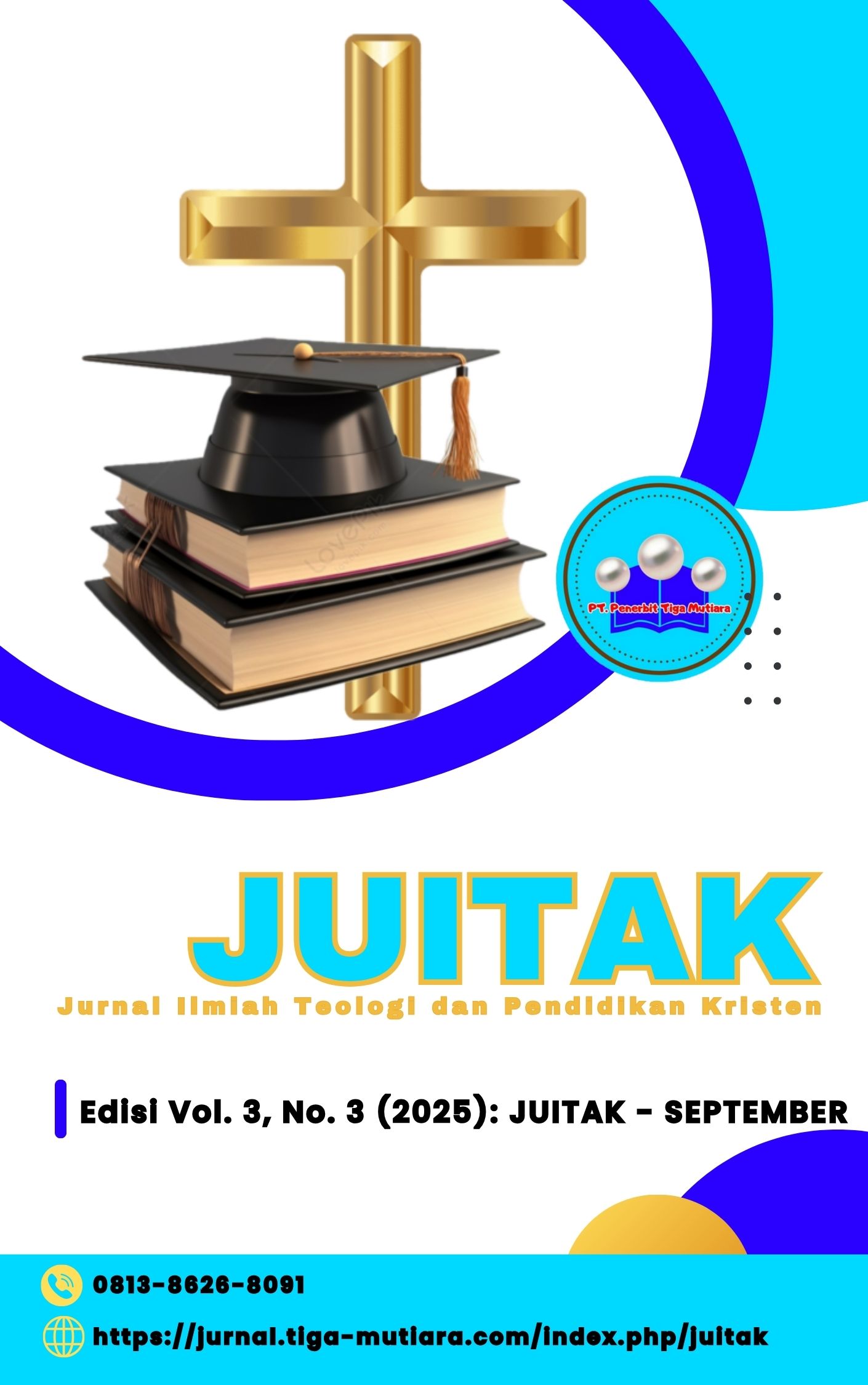Antara Harapan dan Kehampaan: Teologi Eksistensial Pengkhotbah 9:1-6 dan Ambisi Manusia
DOI:
https://doi.org/10.61404/juitak.v3i3.410Keywords:
Contextual Theology, Death, Existential CritiqueAbstract
Ecclesiastes 9:1-6 presents a fundamental and provocative theological statement about the reality of death as an inevitable fate for all humanity, without distinguishing between the righteous and the wicked. This discourse explicitly challenges the retributive ethical framework that assumes a linear relationship between morality and reward, while also revealing the existential absurdity of humans who often seek meaning through fragile worldly achievements. This study aims to interpret the pericope through an existential and contextual theological approach, focusing on its theological relevance in addressing the crisis of spirituality and ethics in modern culture dominated by ambition for power, economic exploitation, and the marginalization of transcendental values. Utilizing a reflective-critical hermeneutical method, this study argues that awareness of mortality should not lead to ontological despair, but rather serve as a starting point for forming a more authentic, relational, and ethical orientation to life. Death in this text functions as an epiphanic moment that unveils human limitations while reorienting existential focus toward God and social responsibility. The novelty of this research lies in its prophetic reading of a wisdom text that has often been interpreted pessimistically, highlighting its potential as a theological critique against modern nihilistic and anti-spiritual ideologies. This study contributes to the development of a contextual theological framework capable of constructively and transformatively responding to the crisis of meaning and ethics in contemporary society.
Downloads
References
Astuti, Eriana Widya, dan Yunanto Wiji Utomo. “Raja Ampat, Jejak Kerusakan Hutan, dan Harapannya.” Kompas.com. Last modified 2025. https://lestari.kompas.com/read/2025/06/07/110300586/raja-ampat-jejak-kerusakan-hutan-dan-harapannya.
Blommendaal, J. Pengantar kepada Perjanjian Lama. Cet. 15. Jakarta: Gunung Mulia, 2008.
Groenen, C. Pengantar ke dalam Perjanjian Lama. Yogyakarta: Kanisius, 1980.
Hill, Andrew E., dan John H. Walton. Survei Perjanjian Lama. Edisi Revi. Malang: Gandum Mas, 1991.
Kabuki. “Menyadari Kematian, Membuka Diri terhadap yang Lain, dalam Realitas Acak yang Membingungkan: Pandangan Teologi berdasarkan Pembacaan Pengkhotbah 9:1-12.” Syarikat Moriah. Last modified 2020. https://kreselubung.wordpress.com/2020/07/29/menyadari-kematian-membuka-diri-terhadap-yang-lain-dalam-realitas-acak-yang-membingungkan-pandangan-teologi-berdasarkan-pembacaan-pengkhotbah-91-12/.
Koosed, Jennifer L. (Per)mutations of Qohelet: Reading the Body in the Book. London: Bloomsbury Publishing, 2006.
Kusradi, Sri Wahyuni. “Lebih Baik Hikmat dari pada Keperkasaan (Suatu Study Eksegetis Pengkhotbah 9:13-18 dan Relevansinya bagi Para Pemimpin Kristen).” SCRIPTA: Jurnal Teologi dan Pelayanan Kontekstual 1, no. 1 (2016): 64–83. https://www.researchgate.net/publication/349619136_LEBIH_BAIK_HIKMAT_DARI_PADA_KEPERKASAAN_Suatu_Study_Eksegetis_Pengkhotbah_9_13-18_Dan_Relevansinya_Bagi_Para_Pemimpin_Kristen.
Lontoh, Frederich Oscar L. METODE PENELITIAN Dilengkapi dengan Aplikasinya untuk Teologi dan Pendidikan Agama Kristen. Cet. 1. Yogyakarta: Stiletto Book, 2024.
Nggebu, Sostenis. “Korupsi dalam Sorotan Etika Kristen dan Implikasinya bagi Pendidikan Anti Korupsi.” Didache: Journal of Christian Education 2, no. 1 (2021): 20–42. https://journal.sttsimpson.ac.id/index.php/DJCE/article/view/386.
Nowak, Piotr Grzegorz. “Death as the Cessation of an Organism and the Moral Status Alternative.” The Journal of Medicine and Philosophy 48, no. 5 (2023): 504–518. https://pmc.ncbi.nlm.nih.gov/articles/PMC10501183/.
Nursantosa, Andre Putranto. “Kapan Allah Membuat Segalanya Indah: Misteri Waktu dalam Kitab Pengkhotbah 3:11.” MELINTAS an International Journal of Philosophy and Religion 33, no. 2 (2017): 157–184. https://journal.unpar.ac.id/index.php/melintas/article/view/2959/.
Situmorang, Winda Kurniati, dan Netty Tesa Yolanika Sitompul. “Nasehat Bijaksana dari Kitab Pengkhotbah 11:9-10 bagi Muda-Mudi Kristen.” Jurnal Pendidikan Sosial dan Humaniora 3, no. 2 (2024): 1309–1314. https://publisherqu.com/index.php/pediaqu/article/view/1017.
Solin, Selvian Naibaho Ncihur Fronika, dan Herdiana Boru Hombing. “Menikamati Masa Muda; Pengkotbah 11:9-10; 12:1-8.” Jurnal Eksplorasi Teologi 8, no. 6 (2024): 10–15. https://ojs.co.id/1/index.php/jet/article/view/1396/.
Sugiyono. Metode Penelitian Kombinasi (Mixed Methods). Bandung: CV. Alfabeta, 2018.
Suharyo, Ignatius, dan Wim van der Weiden. Pengantar Kitab Suci Perjanjian Lama. Cet. 1. Yogyakarta: Kanisius, 2000.
Sujarweni, V. Wiratna. Metodologi Penelitian: Lengkap, Praktik, dan Mudah Dipahami. Yogyakarta: Pustaka Baru Press, 2014.
Tobing, Gebriel Lumban, Roselita Sinaga, dan Michael Juan Nababan. “Teologi Kesia-siaan menurut Kitab Pengkhotbah.” Lumen: Jurnal Pendidikan Agama Katekese dan Pastoral 3, no. 1 (2024): 123–132. https://ejurnal.stpkat.ac.id/index.php/lumen/article/view/333.
Downloads
Published
How to Cite
Issue
Section
License
Copyright (c) 2025 *Jane Isye Lambiombir

This work is licensed under a Creative Commons Attribution-ShareAlike 4.0 International License.














